MTS Landmark Tabletop User Manual
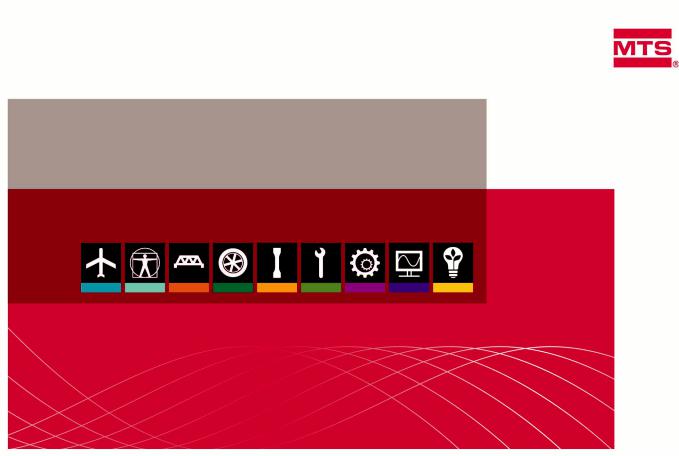
MTS Landmark™ Tabletop Load Units Product
Information
Landmark™ Axial Load Unit, Landmark™ 100 Hz
Elastomer, Bionix®
Axial/Torsional
100-206-897 E |
be certain. |
© 2013 MTS Systems Corporation. All rights reserved.
Original Instructions (English): 100-206-897 E
Trademark Information
MTS, be certain., Bionix, ElastomerExpress, FlatTrac, FlexTest, Just In Case, LevelPlus, MTS Criterion, MTS EM Extend, MTS Insight, MTS Landmark, RPC, ServoSensor, SWIFT, Temposonics, TestWare, TestWorks are registered trademarks of MTS Systems Corporation within the United States. Acumen, Advantage, Aero ST, Aero-90, AeroPro, Criterion, CRPC, Echo, Flat-Trac, Landmark, MAST, MicroProfiler, MPT, MTS Acumen, MTS Echo, MTS Fundamentals, MTS TestSuite, ReNew, SilentFlo, TempoGuard, TestLine, and Tytron are trademarks of MTS Systems Corporation within the United States. These trademarks may be registered in other countries. All other trademarks are property of their respective owners.
Proprietary Software
Software use and license is governed by the MTS End User License Agreement which defines all rights retained by MTS and granted to the End User. All Software is proprietary, confidential, and owned by MTS Systems Corporation and cannot be copied, reproduced, disassembled, decompiled, reverse engineered, or distributed without express written consent of MTS.
Software Verification and Validation
MTS software is developed using established quality practices in accordance with the requirements detailed in the ISO 9001 standards. Because MTS-authored software is delivered in binary format, it is not user accessible. This software will not change over time. Many releases are written to be backwards compatible, creating another form of verification. The status and validity of the MTS operating software is also checked during system verification and routine calibration of MTS hardware. These controlled calibration processes compare the final test results after statistical analysis against the predicted response of the calibration standards. With these established methods, MTS assures its customers that MTS products meet exacting quality standards when initially installed and will continue to perform as intended over time.
Manual Part Number—Publication Date—Release
100-206-897 E—November 2013
100-206-897 D—July 2011
100-206-897 C1—April 2011
100-206-897 C—March 2010
100-206-897 B—April 2009
100-206-897 A—November 2008
Contents |
|
Technical Support |
7 |
How to Get Technical Support................................................................................................................. |
7 |
Before You Contact MTS......................................................................................................................... |
7 |
If You Contact MTS by Phone................................................................................................................. |
9 |
Problem Submittal Form in MTS Manuals............................................................................................ |
10 |
Preface |
11 |
Before You Begin................................................................................................................................... |
11 |
Documentation Conventions.................................................................................................................. |
11 |
Safety |
15 |
General Safety Practices......................................................................................................................... |
16 |
Safety Practices Before Operating the System....................................................................................... |
16 |
Safety Practices While Operating the System ....................................................................................... |
20 |
Load Unit Hazard Labels....................................................................................................................... |
22 |
Introduction |
27 |
Overview................................................................................................................................................ |
28 |
What you need to know.............................................................................................................. |
29 |
Related products......................................................................................................................... |
29 |
EU Declarations..................................................................................................................................... |
29 |
Component Description.......................................................................................................................... |
31 |
Functional Description........................................................................................................................... |
33 |
Series 661 Force Transducers................................................................................................................. |
34 |
Dimensions................................................................................................................................. |
35 |
Series 662 Force Transducers................................................................................................................. |
36 |
Dimensions................................................................................................................................. |
37 |
Specifications......................................................................................................................................... |
37 |
Installation |
39 |
About Installation................................................................................................................................... |
40 |
Lifting and Moving the Load Unit......................................................................................................... |
40 |
Overview.................................................................................................................................... |
40 |
Lift and Move the Load Unit...................................................................................................... |
41 |
Connecting Cables.................................................................................................................................. |
48 |
Prerequisite................................................................................................................................. |
48 |
Cable connections....................................................................................................................... |
48 |
Low Flow Power Supply............................................................................................................ |
48 |
Connect Hydraulics................................................................................................................................ |
50 |
MTS Landmark™ Tabletop Load Units Product Information 3
Unlock the Crosshead............................................................................................................................. |
51 |
Operation |
55 |
Control Module...................................................................................................................................... |
56 |
Specimen Installation............................................................................................................................. |
57 |
Install the Specimen................................................................................................................... |
58 |
Position the Crosshead Manually........................................................................................................... |
59 |
Manually Clamp the Crosshead ................................................................................................ |
62 |
Crosshead Clamping Bolt Torque Values................................................................................... |
63 |
Move the Crosshead Hydraulically........................................................................................................ |
63 |
Adjust the Grip Clamp Rate................................................................................................................... |
64 |
Adjust the Grip Clamp Force................................................................................................................. |
65 |
Handset Control...................................................................................................................................... |
66 |
Handset Control Functions......................................................................................................... |
66 |
Standard Test Area Enclosure Operation............................................................................................... |
67 |
Hydraulic Power Off.................................................................................................................. |
68 |
Specimen Installation and Setup................................................................................................ |
68 |
Specimen Installation and Setup–Interrupt Operation................................................... |
68 |
Specimen Installation and Setup–Resume Operation.................................................... |
68 |
Run Mode................................................................................................................................... |
69 |
Service........................................................................................................................................ |
69 |
Emergency Stop and Actuator Velocity Limiting Switch.......................................................... |
69 |
Interlock logic............................................................................................................................ |
70 |
Test Area Enclosure with Light Curtain................................................................................................. |
70 |
Maintenance |
73 |
Routine Maintenance Overview Checklist............................................................................................. |
74 |
Other Maintenance Tasks....................................................................................................................... |
77 |
Daily Inspections.................................................................................................................................... |
78 |
Clean the Columns................................................................................................................................. |
79 |
Prevent Rust........................................................................................................................................... |
80 |
Maintain Airmount Pressures................................................................................................................. |
82 |
Label Inspection..................................................................................................................................... |
84 |
Adjust the Hydraulic Locks.................................................................................................................... |
84 |
Lubricate the Crosshead Locking Bolts................................................................................................. |
88 |
Aligning the Force Transducer............................................................................................................... |
89 |
Required Equipment................................................................................................................... |
89 |
Align the Force Transducer........................................................................................................ |
89 |
Series 111 Accumulator: Maintenance Overview.................................................................................. |
93 |
Series 111 Accumulator: Check and Change Precharge Pressure.......................................................... |
95 |
Equipment.................................................................................................................................. |
95 |
Prerequisites............................................................................................................................... |
95 |
Check the Precharge Pressure.................................................................................................... |
96 |
4 MTS Landmark™ Tabletop Load Units Product Information
Change the Precharge Pressure.................................................................................................. |
98 |
Decrease Pressure........................................................................................................... |
98 |
Increase Pressure ........................................................................................................... |
98 |
Actuator.................................................................................................................................................. |
99 |
Change the HSM Filter........................................................................................................................ |
100 |
Change the HSM Filter............................................................................................................ |
101 |
252 Servovalve..................................................................................................................................... |
102 |
Replacing the Servovalve Filter Element................................................................................. |
102 |
Replace the Servovalve Filter Element.................................................................................... |
102 |
Adjusting the Mechanical Null................................................................................................. |
105 |
Adjust the Mechanical Null...................................................................................................... |
105 |
Performing Sensor Calibration............................................................................................................. |
108 |
Decommissioning |
109 |
Decommission the System................................................................................................................... |
110 |
Declarations |
113 |
Declaration of Conformity................................................................................................................... |
114 |
Declaration of Incorporation................................................................................................................ |
117 |
MTS Landmark™ Tabletop Load Units Product Information 5

Technical Support
How to Get Technical Support
Start with your manuals
The manuals supplied by MTS provide most of the information you need to use and maintain your equipment. If your equipment includes software, look for online help and README files that contain additional product information.
Technical support methods
MTS provides a full range of support services after your system is installed. If you have any questions about a system or product, contact Technical Support in one of the following ways.
Web site |
www.mts.com > Contact Us (upper-right corner) > In the Subject field, choose |
|
To escalate a problem; Problem Submittal Form |
Worldwide: tech.support@mts.com |
|
|
Europe: techsupport.europe@mts.com |
Telephone |
Worldwide: 1 800 328 2255 - toll free in U.S.; +1 952 937 4000 - outside U.S. |
|
Europe: +800 81002 222, International toll free in Europe |
Outside the U.S.
For technical support outside the United States, contact your local sales and service office. For a list of worldwide sales and service locations and contact information, use the Global MTS link at the MTS web site:
www.mts.com > Global Presence > Choose a Region
Before You Contact MTS
MTS can help you more efficiently if you have the following information available when you contact us for support.
Know your site number and system number
The site number contains your company number and identifies your equipment type (such as material testing or simulation). The number is typically written on a label on your equipment before the system leaves MTS. If you do not know your MTS site number, contact your sales engineer.
Example site number: 571167
MTS Landmark™ Tabletop Load Units Product Information 7
When you have more than one MTS system, the system job number identifies your system. You can find your job number in your order paperwork.
Example system number: US1.42460
Know information from prior technical assistance
If you have contacted MTS about this problem before, we can recall your file based on the:
•MTS notification number
•Name of the person who helped you
Identify the problem
Describe the problem and know the answers to the following questions:
•How long and how often has the problem occurred?
•Can you reproduce the problem?
•Were any hardware or software changes made to the system before the problem started?
•What are the equipment model numbers?
•What is the controller model (if applicable)?
•What is the system configuration?
Know relevant computer information
For a computer problem, have the following information available:
•Manufacturer’s name and model number
•Operating software type and service patch information
•Amount of system memory
•Amount of free space on the hard drive where the application resides
•Current status of hard-drive fragmentation
•Connection status to a corporate network
Know relevant software information
For software application problems, have the following information available:
•The software application’s name, version number, build number, and (if available) software patch number. This information can typically be found in the About selection in the Help menu.
•The names of other applications on your computer, such as:
•Anti-virus software
•Screen savers
•Keyboard enhancers
•Print spoolers
•Messaging applications
8 MTS Landmark™ Tabletop Load Units Product Information

If You Contact MTS by Phone
A Call Center agent registers your call before connecting you with a technical support specialist. The agent asks you for your:
•Site number
•Name
•Company name
•Company address
•Phone number where you can be reached
If your issue has a notification number, please provide that number. A new issue will be assigned a unique notification number.
Identify system type
To enable the Call Center agent to connect you with the most qualified technical support specialist available, identify your system as one of the following types:
•Electrodynamic material test system
•Electromechanical material test system
•Hydromechanical material test system
•Vehicle test system
•Vehicle component test system
•Aero test system
Be prepared to troubleshoot
Prepare to perform troubleshooting while on the phone:
•Call from a telephone close to the system so that you can implement suggestions made over the phone.
•Have the original operating and application software media available.
•If you are not familiar with all aspects of the equipment operation, have an experienced user nearby to assist you.
Write down relevant information
In case Technical Support must call you:
•Verify the notification number.
•Record the name of the person who helped you.
•Write down any specific instructions.
MTS Landmark™ Tabletop Load Units Product Information 9

After you call
MTS logs and tracks all calls to ensure that you receive assistance for your problem or request. If you have questions about the status of your problem or have additional information to report, please contact Technical Support again and provide your original notification number.
Problem Submittal Form in MTS Manuals
Use the Problem Submittal Form to communicate problems with your software, hardware, manuals, or service that are not resolved to your satisfaction through the technical support process. The form includes check boxes that allow you to indicate the urgency of your problem and your expectation of an acceptable response time. We guarantee a timely response—your feedback is important to us.
You can access the Problem Submittal Form at www.mts.com > Contact Us (upper-right corner) > In the
Subject field, choose To escalate a problem; Problem Submittal Form
10 MTS Landmark™ Tabletop Load Units Product Information

Preface
Before You Begin
Safety first!
Before you use your MTS product or system, read and understand the safety information provided with your system. Improper installation, operation, or maintenance can result in hazardous conditions that can cause severe personal injury or death, or damage to your equipment and specimen. Again, read and understand the safety information provided with your system before you continue. It is very important that you remain aware of hazards that apply to your system.
Other MTS manuals
In addition to this manual, you may receive additional manuals in paper or electronic form.
You may also receive an MTS System Documentation CD. It contains an electronic copy of the manuals that pertain to your test system.
Controller and application software manuals are typically included on the software CD distribution disc(s).
Documentation Conventions
The following paragraphs describe some of the conventions that are used in your MTS manuals.
Hazard conventions
Hazard notices may be embedded in this manual. These notices contain safety information that is specific to the activity to be performed. Hazard notices immediately precede the step or procedure that may lead to an associated hazard. Read all hazard notices carefully and follow all directions and recommendations. Three different levels of hazard notices may appear in your manuals. Following are examples of all three levels. (for general safety information, see the safety information provided with your system.)
Danger:
Danger notices indicate the presence of a hazard with a high level of risk which, if ignored, will result in death, severe personal injury, or substantial property damage.
MTS Landmark™ Tabletop Load Units Product Information 11
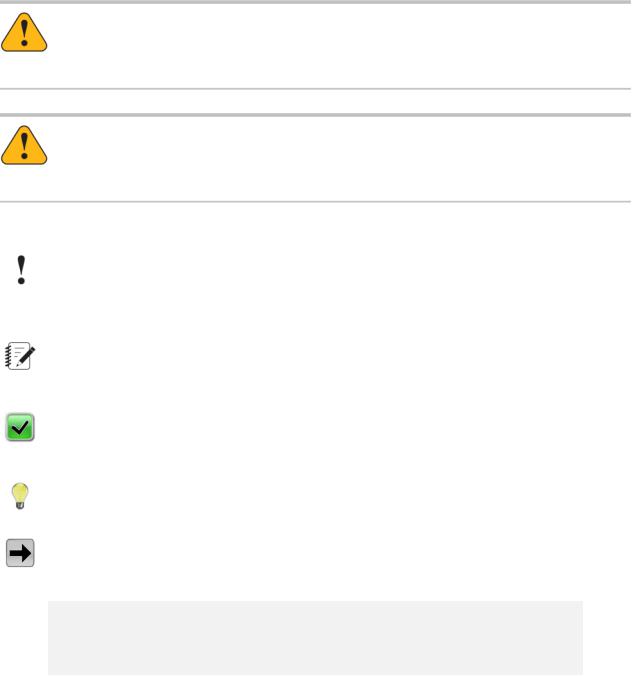
Warning:
Warning notices indicate the presence of a hazard with a medium level of risk which, if ignored, can result in death, severe personal injury, or substantial property damage.
Caution:
Caution notices indicate the presence of a hazard with a low level of risk which, if ignored, could cause moderate or minor personal injury or equipment damage, or could endanger test integrity.
Other special text conventions
Important:
Important notices provide information about your system that is essential to its proper function. While not safety-related, if the important information is ignored, test results may not be reliable, or your system may not operate properly.
Note:
Notes provide additional information about operating your system or highlight easily overlooked information.
Recommended:
Recommended notes provide a suggested way to accomplish a task based on what MTS has found to be most effective.
Tip:
Tips provide helpful information or a hint about how to most efficiently accomplish a task.
Access:
Access provides the route you should follow to a referenced item in the software.
Example:
Examples show specific scenarios relating to your product and appear with a shaded background.
Special terms
The first occurrence of special terms is shown in italics.
Illustrations
Illustrations appear in this manual to clarify text. They are examples only and do not necessarily represent your actual system configuration, test application, or software.
Electronic manual conventions
This manual is available as an electronic document in the Portable Document File (PDF) format. It can be viewed on any computer that has Adobe Acrobat Reader installed.
12 MTS Landmark™ Tabletop Load Units Product Information
Hypertext links
The electronic document has many hypertext links displayed in a blue font. All blue words in the body text, along with all contents entries and index page numbers, are hypertext links. When you click a hypertext link, the application jumps to the corresponding topic.
MTS Landmark™ Tabletop Load Units Product Information 13

Safety
Topics: |
|
|
• |
General Safety Practices....................................................................................................................... |
16 |
• Safety Practices Before Operating the System..................................................................................... |
16 |
|
• Safety Practices While Operating the System ...................................................................................... |
20 |
|
• |
Load Unit Hazard Labels....................................................................................................................... |
22 |
MTS Landmark™ Tabletop Load Units Product Information 15

Safety
General Safety Practices
If you have system related responsibilities (that is, if you are an operator, service engineer, or maintenance person), you should study this manual carefully before you attempt to perform any test system procedure.
You should receive training on this system or a similar system to ensure a thorough knowledge of your equipment and the safety issues that are associated with its use. In addition, you should gain an understanding of system functions by studying the other manuals supplied with your test system. Contact MTS for information about the content and dates of training classes that are offered.
It is very important that you study the following safety information to ensure that your facility procedures and the system’s operating environment do not contribute to or result in a hazardous situation. Remember, you cannot eliminate all the hazards associated with this system, so you must learn and remain aware of the hazards that apply to your system at all times. Use these safety guidelines to help learn and identify hazards so that you can establish appropriate training and operating procedures and acquire appropriate safety equipment (such as gloves, goggles, and hearing protection).
Each test system operates within a unique environment which includes the following known variables:
•Facility variables (facility variables include the structure, atmosphere, and utilities)
•Unauthorized customer modifications to the equipment
•Operator experience and specialization
•Test specimens
Because of these variables (and the possibility of others), your system can operate under unforeseen circumstances that can result in an operating environment with unknown hazards.
Improper installation, operation, or maintenance of your system can result in hazardous conditions that can cause death, personal injury, or damage to the equipment or to the specimen. Common sense and a thorough knowledge of the system’s operating capabilities can help to determine an appropriate and safe approach to its operation.
Observe the prescribed safety practices before and during system operation.
It is the user’s responsibility to take the machine out of service and contact MTS Service if discrepancies in system operation are found.
Safety Practices Before Operating the System
Before you apply power to the test system, review and complete all of the safety practices that are applicable to your system. The goal, by doing this, is to improve the safety awareness of all personnel involved with the system and to maintain, through visual inspections, the integrity of specific system components.
Read all manuals
Study the contents of this manual and the other manuals provided with your system before attempting to perform any system function for the first time. Procedures that seem relatively simple or intuitively obvious can require a complete understanding of system operation to avoid unsafe or dangerous situations.
16 MTS Landmark™ Tabletop Load Units Product Information
Safety
Locate lockout/tagout points
Know where the lockout/tagout point is for each of the supply energies associated with your system. This includes the hydraulic, pneumatic, electric, and water supplies (as appropriate) for your system to ensure that the system is isolated from these energies when required.
Know facility safe procedures
Most facilities have internal procedures and rules regarding safe practices within the facility. Be aware of these safe practices and incorporate them into your daily operation of the system.
Locate Emergency Stop buttons
Know the location of all the system Emergency Stop buttons so that you can stop the system quickly in an emergency. Ensure that an Emergency Stop button is located within close proximity of the operator at all times.
Know controls
Before you operate the system for the first time, make a trial run through the operating procedures with the power off. Locate all hardware and software controls and know what their functions are and what adjustments they require. If any control function or operating adjustment is not clear, review the applicable information until you understand it thoroughly.
Have first aid available
Accidents can happen even when you are careful. Arrange your operator schedules so that a properly trained person is always close by to render first aid. In addition, ensure that local emergency contact information is posted clearly and in sight of the system operator.
Know potential crush and pinch points
Be aware of potential crush and pinch points on your system and keep personnel and equipment clear of these areas.
An important consideration for servohydraulic systems is that when power is interrupted, it is likely that stored accumulator pressure will persist for some time within the system. In addition, it is likely that as stored energy dissipates, gravity will cause portions of the system to move.
Be aware of component movement with hydraulics off
For hydraulic systems, be aware that mechanical assemblies can shift or drift due to changes within hydraulic hardware when hydraulics are turned off. This non-commanded movement is because oil can transfer between the pressure and return ports and across internal components of the hydraulic hardware. Be aware that this can happen and clear the area around the mechanical assemblies when hydraulics are turned off.
Know electrical hazards
When the system electrical power is turned on, minimize the potential for electrical shock hazards. Wear clothing and use tools that are properly insulated for electrical work. Avoid contact with exposed wiring or switch contacts.
Whenever possible, turn off electrical power when you work on or in proximity to any electrical system component. Observe the same precautions as those given for any other high-voltage machinery.
Make sure that all electrical components are adequately grounded. Grounds must remain connected and undisturbed at all times.
MTS Landmark™ Tabletop Load Units Product Information 17
Safety
Ensure Correct Cable Connection
If a system cable has been disconnected, ensure that you establish the correct cable-to-connector relationship during reconnection. Incorrect cable connections can result in improper servo loop phasing or an open servo loop condition, either of which can cause unstable or unexpected and potentially dangerous system motions. Verify the correct cable-to-connector relationship by observing the cable and connector labeling and the system wiring schematics.
Keep bystanders safely away
Keep bystanders at a safe distance from all equipment. Never allow bystanders to be in close proximity of specimens or equipment while the test is running.
Wear proper clothing
Do not wear neckties, shop aprons, loose clothing or jewelry, or long hair that could get caught in equipment and result in an injury. Remove loose clothing or jewelry and restrain long hair.
Remove flammable fluids
Remove flammable fluids from their containers or from components before you install the container or component. If desired, you can replace the flammable fluid with a non-flammable fluid to maintain the proper proportion of weight and balance.
Know compressed gas hazards
Your system may contain accumulators that require a high-pressure gas precharge (pressures that exceed 138 bar [2000 psi]). High-pressure devices are potentially dangerous because a great amount of energy is available in the event of an uncontrolled expansion or rupture.
Observe the following safety practices when you work with high-pressure air or gases:
•When you charge an accumulator, follow all the charging instructions provided in the appropriate product information manuals. When precharging accumulators, properly identify the type of gas to be used and the type of accumulator to be precharged.
•Use only dry-pumped nitrogen to precharge nitrogen-charged accumulators. (Dry-pumped nitrogen can also be labeled “oil pumped” or “dry water pumped.”) Do not use compressed air or oxygen for precharging: the temperature increase caused by rapid gas compression can result in highly explosive conditions when hydraulic fluid is in the presence of oxygen or compressed air.
•Always follow the recommended bleeding procedures before you remove or disassemble components that contain pressurized gas. When you bleed a gas or remove a fitting, hose, or component that contains a gas, remember that many gases cannot support life. Therefore, as the ratio of released gas to oxygen increases, so does the potential for suffocation.
•Wear appropriate safety devices to protect your hearing. Escaping air or gas can create a noise level that can damage your hearing.
•Ensure that all pressurized air or gas is bled out of a pneumatic or gas-charged device before you start to disassemble it. A thorough understanding of the assembly and its pressurized areas is necessary before you undertake any maintenance. Refer to the appropriate product information for the correct bleeding procedure.
It may not be obvious or intuitive which bolts or fittings are used to restrain a pressurized area. On some assemblies, you must remove a cover plate to gain access to the structural bolts. Sometimes, to protect you from a rapid release of trapped gases, a small port is exposed when you remove this cover plate.
Exposing this port ensures that the gas precharge is fully bled before disassembly. However, this is not the recommended procedure for bleeding a pneumatic or gas-charged device, because it can expose you
18 MTS Landmark™ Tabletop Load Units Product Information
Safety
to the dangers of escaping compressed gas and particulates that are expelled from the chamber or around the seals. Do not assume that cover plates and ports are installed in all the critical locations.
Consult MTS when in doubt about the safety or reliability of any system-related procedure or modification that involves devices that contain any type of compressed gas.
Check bolt ratings and torques
To ensure a reliable product, fasteners (such as bolts and tie rods) used in MTS-manufactured systems are torqued to specific requirements. If a fastener is loosened or the configuration of a component within the system is modified, refer to the system and component assembly drawings (located on the System Documentation CD) to determine the correct fastener, fastener rating, and torque. Over torquing or under torquing a fastener can create a hazardous situation due to the high forces and pressures present in MTS test systems.
On rare occasions, a fastener can fail even when it is correctly installed. Failure usually occurs during torquing, but it can occur several days later. Failure of a fastener can result in a high velocity projectile. Therefore, it is a good practice to avoid stationing personnel in line with or below assemblies that contain large or long fasteners.
Practice good housekeeping
Keep the floors in the work area clean. Industrial chemicals, such as hydraulic fluid, that are spilled on any type of floor can result in a dangerous, slippery surface. Do not leave tools, fixtures, or other items not specific to the test, lying about on the floor, system, or decking.
Protect hoses and cables
Protect electrical cables from spilled fluids and from excessive temperatures that can cause the cables to harden and eventually fail. Ensure that all cables have appropriate strain relief devices installed at the cable and near the connector plug. Do not use the connector plug as a strain relief.
Protect all system hoses and cables from sharp or abrasive objects that can cause the hose or cable to fail. Use a cable cover or cable tray where cables are in traffic locations. Never walk on hoses or cables or move heavy objects over them. Route hoses and cables away from areas that expose them to possible damage.
Provide proper hydraulic fluid filtration
For hydraulic systems equipped with a non-MTS hydraulic power unit, make sure that hydraulic fluid filtration is established to maintain fluid cleanliness standards as stated in the Hydraulic Fluid Care Manual (see the System Documentation CD). Particles present in the hydraulic fluid can cause erratic or poor system response.
Protect accumulators from moving objects
For systems equipped with accumulators, protect accumulators with supports or guards. Do not strike accumulators with moving objects. This could cause the accumulator(s) to separate from the manifold resulting in equipment damage and personal injury.
Record changes
If you change any operating procedure, write the change and the date of the change in the appropriate manual.
Provide test area guards
Use protective guards such as cages, enclosures, and special laboratory layouts when you work with hazardous test specimens (for example, brittle or fragmenting materials or materials that are internally pressurized).
MTS Landmark™ Tabletop Load Units Product Information 19

Safety
Do not exceed the Maximum Supply Pressure
For hydraulic systems and components, make sure that hydraulic supply pressure is limited to the maximum pressure defined by the system operating limits. Read and review “System Operating Limits” for the system.
Do not disable safety devices
Your system may have active or passive safety devices installed to prevent system operation if the device indicates an unsafe condition. Do not disable such devices as it may result in unexpected system motion.
Use appropriately sized fuses
Whenever you replace fuses for the system or supply, ensure that you use a fuse that is appropriately sized and correctly installed. Undersized or oversized fuses can result in cables that overheat and fuses that explode. Either instance creates a fire hazard.
Provide adequate lighting
Ensure adequate lighting to minimize the chance of operation errors, equipment damage, and personal injury.
Provide adequate ventilation
Make sure work and maintenance areas are adequately ventilated to minimize the risks associated with the collection of hazardous fumes (such as vaporized hydraulic fluid). This is of special concern in confined areas where hydraulic equipment is operating at high pressure in confined areas.
Provide means to access out-of-reach components
Make sure you can access system components that might be out of reach while standing on the floor. For example, ladders or scaffolding might be required to reach load cell connectors on tall load units.
Safety Practices While Operating the System
Wear appropriate personal protection
Wear eye protection when you work with high-pressure hydraulic fluid, high-pressure air pressure, breakable specimens, or when anything characteristic to the specimen could break apart.
Wear ear protection when you work near electric motors, pumps, or other devices that generate high noise levels. This system may create sound pressure levels that exceed 70 dbA during operation.
Wear appropriate protection (gloves, boots, suits, respirators) whenever you work with fluids, chemicals, or powders that may irritate or harm the skin, respiratory system, or eyes.
Provide test area enclosures
Use protective enclosures such as cages or shields, and special laboratory layouts when you work with hazardous test specimens (for example, brittle or fragmenting materials or materials that are internally pressurized).
Customer must evaluate risks due to ejected parts or materials from the test specimens. If the MTS Test Area Enclosure option is not selected by the customer, then for protection against ejected parts or materials from test specimens and to control access to the machinery, the Customer must provide a Test Area Enclosure to protect personnel.
20 MTS Landmark™ Tabletop Load Units Product Information
Safety
Specimen temperature changes
During cyclic testing, the specimen temperature can become hot enough to cause burns. Wear personal protection equipment (gloves) when handling specimens.
Handle chemicals safely
Whenever you use or handle chemicals (for example, hydraulic fluid, batteries, contaminated parts, electrical fluids, and maintenance waste), refer to the appropriate MSDS documentation for that material and determine the appropriate measures and equipment required to handle and use the chemical safely. Ensure that the chemical is disposed of appropriately.
Know servohydraulic system interlocks
Interlock devices should always be used and properly adjusted. Interlock devices are designed to minimize the chance of accidental damage to the test specimen or the equipment. Test all interlock devices for proper operation immediately before a test. Do not disable or bypass any interlock devices as doing so could allow hydraulic pressure to be applied regardless of the true interlock condition. The Reset/Override button is a software function that can be used to temporarily override an interlock while attempting to start the hydraulic power unit and gain control of the system.
Know system limits
Never rely on system limits such as mechanical limits or software limits to protect you or any personnel. System limits are designed to minimize the chance of accidental damage to test specimens or to equipment. Test all limits for proper operation immediately before a test. Always use these limits and adjust them properly.
Do not disturb sensors
Do not bump, wiggle, adjust, disconnect, or otherwise disturb a sensor (such as an accelerometer or extensometer) or its connecting cable when hydraulic pressure is applied.
Ensure secure cables
Ensure that all cable connections (electrical supply, control, feedback, sensor, communications, and so forth) are either locking type, or are secured, to ensure that they cannot be disconnected by a simple act. Do not change any cable connections when electrical power or hydraulic pressure is applied. If you attempt to change a cable connection while the system is in operation, an open control loop condition can result. An open control loop condition can cause a rapid, unexpected system response which can result in severe personal injury, death, or damage to equipment. Also, ensure that all cables are connected after you make any changes in the system configuration.
Stay alert
Avoid long periods of work without adequate rest. In addition, avoid long periods of repetitious, unvarying, or monotonous work because these conditions can contribute to accidents and hazardous situations. If you are too familiar with the work environment, it is easy to overlook potential hazards that exist in that environment.
Contain small leaks
Do not use your fingers or hands to stop small leaks in hydraulic or pneumatic hoses. Substantial pressures can build up, especially if the hole is small. These high pressures may cause the oil or gas to penetrate your skin, causing painful and dangerously infected wounds. Turn off the hydraulic supply and allow the hydraulic pressure to dissipate before you remove and replace the hose or any pressurized component.
Stay clear of moving equipment/avoid crush points
Stay clear of mechanical linkages, connecting cables, and hoses that move because you may get pinched, crushed, tangled, or dragged along with the equipment. High forces generated by the system can pinch, cut,
MTS Landmark™ Tabletop Load Units Product Information 21

Safety
or crush anything in the path of the equipment and cause serious injury. Stay clear of any potential crush points. Most test systems can produce sudden, high-force motion. Never assume that your reactions are fast enough to allow you to escape injury when a system fails.
Know the causes of unexpected actuator motions
The high force and velocity capabilities of MTS actuators can be destructive and dangerous (especially if actuator motion is unexpected). The most likely causes of unexpected actuator response are operator error and equipment failure due to damage or abuse (such as broken, cut, or crushed cables and hoses; shorted wires; overstressed feedback devices; and damaged components within the servocontrol loop). Eliminate any condition that could cause unexpected actuator motion.
Do not use RF transmitters
Keep radio frequency (RF) transmitters away from the workstation computers, remote terminals, and electronics consoles. Intense RF fields can cause erratic operation of the more sensitive circuits in the system.
Load Unit Hazard Labels
Two sets of labels are used for the load frames: one set for North America and one set for rest of the world.
Hazard Labels North America (part number 100-164-553)
22 MTS Landmark™ Tabletop Load Units Product Information
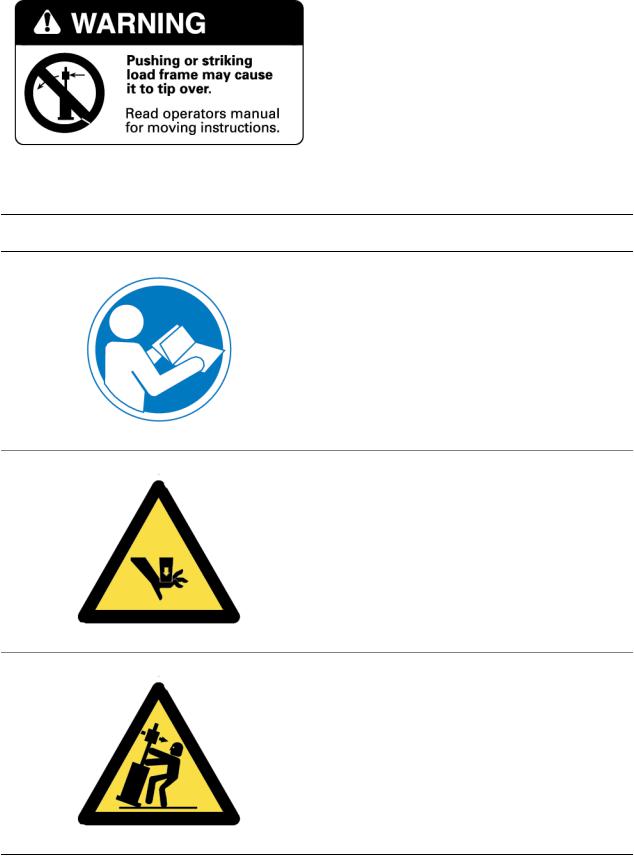
Safety
Hazard Labels Rest of World (part number 100-164-565)
Icon |
Description |
Failure to follow operating instructions can cause death or serious injury.
Read and understand the operator’s manual before using this machine.
Moving parts can crush and cut.
Keep hands clear while operating machine.
Pushing or striking load frame may cause it to tip over.
Read the operator’s manual for moving instructions.
MTS Landmark™ Tabletop Load Units Product Information 23
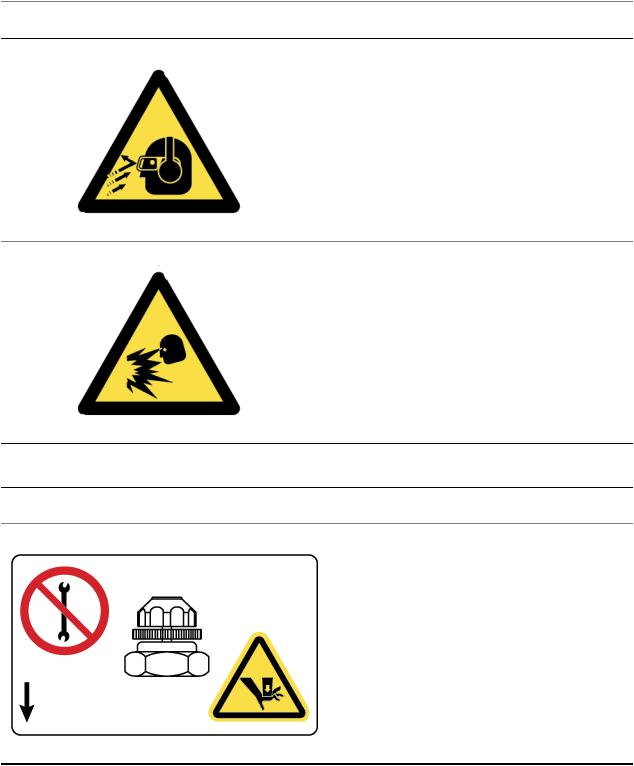
Safety
Icon |
Description |
Flying debris and loud noise hazard.
Wear ear and eye protection.
Hydraulic pressure beyond rated working pressure can rupture components, cause severe personal injury, and damage equipment.
Do not exceed 21 MPa (3000 psi) rated working pressure.
Hazard Label for HSM Needle Valve Adjustment |
|
Icon |
Description |
|
The HSM needle valve is factory adjusted and should |
|
not be adjusted in the field except by MTS Field |
|
Service Engineers. |
24 MTS Landmark™ Tabletop Load Units Product Information

|
Safety |
Hazard Label for HSM Needle Valve Adjustment |
|
Icon |
Description |
|
The HSM needle valve is factory adjusted and should |
|
not be adjusted in the field except by MTS Field |
|
Service Engineers. |
MTS Landmark™ Tabletop Load Units Product Information 25

Introduction
Topics: |
|
|
• |
Overview................................................................................................................................................ |
28 |
• |
EU Declarations..................................................................................................................................... |
29 |
• |
Component Description......................................................................................................................... |
31 |
• |
Functional Description........................................................................................................................... |
33 |
• Series 661 Force Transducers............................................................................................................... |
34 |
|
• Series 662 Force Transducers............................................................................................................... |
36 |
|
• |
Specifications......................................................................................................................................... |
37 |
MTS Landmark™ Tabletop Load Units Product Information 27
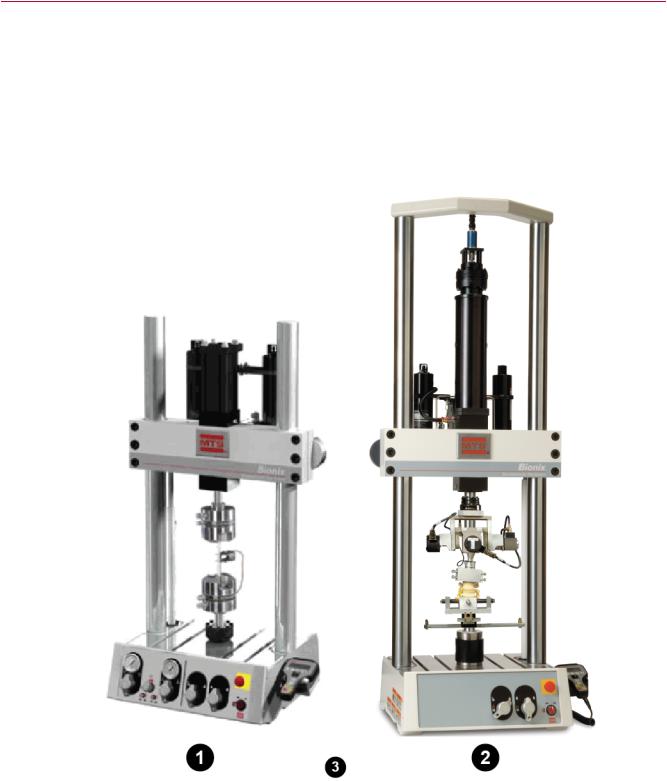
Introduction
Overview
This manual documents Series 370 Tabletop Load Units. These small load units are available in the following configurations:
•The axial load unit has an actuator that applies linear forces to specimens.
•The axial-torsional load unit combines an axial actuator with a torsional actuator to simultaneously apply axial and torsional forces to specimens.
•The 100 Hz elastomer load unit is configured specifically for characterizing the dynamic properties of elastomeric materials and components.
28 MTS Landmark™ Tabletop Load Units Product Information

Introduction
MTS Landmark Tabletop Load Units
Item Description
1Axial
2Axial-Torsional
3Note: Load units are shown with optional grips, fixtures, and accessories.
What you need to know
MTS Systems Corporation assumes that you know how to use your controller. For information about performing any controller-related step in this manual's procedure, see the appropriate manual. You are expected to know how to perform the following procedures:
•Turn hydraulic pressure on and off.
•Select a control mode.
•Adjust the actuator position.
•Zero a sensor signal.
•Zero a sensor output.
•Use your grips and fixtures.
•Define a simple test.
•Run a test.
Related products
The Series 370 Tabletop Load Unit includes several other products. For product-specific information and maintenance procedures, see the following product information manuals.
•The Series 111 Accumulator Product Information manual (MTS part number 011-553-304)
•The Series 252 Servovalve Product Information manual (MTS part number 011-182-906)
EU Declarations
The load units, controllers, and optional equipment are supplied with Product Information manuals that allow them to be assembled and integrated to work as assemblies of machinery.
The customer must evaluate risks due to ejected parts or materials from the test specimens. If the test area enclosure option is not selected by the customer, then for protection against ejected parts or materials from test specimens and to control access to the machinery, the customer must provide a test area enclosure.
MTS Landmark™ Tabletop Load Units Product Information 29
Introduction
EC Declaration of Conformity (Machinery Directive 2006/42/EC Annex II 1A)
The load units are used for testing materials and components and can perform tension, compression, fatigue and fracture mechanics tests. The testing materials and components (test specimens) are supplied by customers or end users.
A combination of one each of an MTS load unit AND one each of an MTS Controller constitute machinery that can be used for specific application(s) as given in this load unit Product Information manual. If the load unit is supplied with an MTS Controller, the Declaration of Conformity is supplied with the machinery; an example of the Declaration of Conformity is provided at the end of this manual.
Optional equipment such as hydraulic service manifolds, a hydraulic power unit, grips, fixtures, extensometers, furnaces, ovens and environmental chambers, and so forth can be used with the machinery. MTS will supply Product Information manuals for optional equipment that allow such equipment to be assembled correctly with the load unit and controller. This will allow the completed system assembly of individual equipment to be controlled as one final machinery.
Declaration of Incorporation (Machinery Directive 2006/42/EC Annex II 1B)
If the load unit is supplied by itself, MTS will only supply a Declaration of Incorporation with the product; an example of the Declaration of Incorporation is provided at the end of this manual. Whenever a Declaration of Incorporation is supplied, it is the responsibility of the customer to perform the Machinery Directive Conformity Assessment procedures and ensure that the complete assembly of machinery sub-systems (load unit, controller, and optional equipment such as hydraulic service manifolds, hydraulic power unit, grips, fixtures, extensometers, furnaces, ovens and environmental chambers, and so forth) conforms to the requirements of Machinery Directive 2006/42/EC and other applicable EC Directives. This will require the customer to affix the CE Marking on the system assembly and to complete the EC Declaration of Conformity before putting the machinery into service.
30 MTS Landmark™ Tabletop Load Units Product Information
